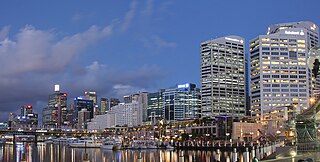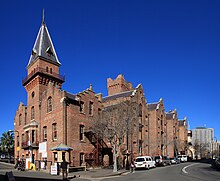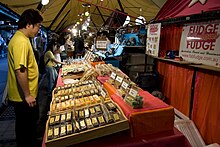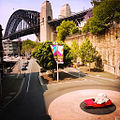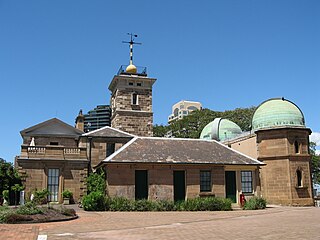
Millers Point is an inner-city suburb of Sydney, in the state of New South Wales, Australia. It is on the north-western edge of the Sydney central business district, adjacent to The Rocks and is part of the local government area of the City of Sydney.

The Australian Hotel is a heritage-listed hotel at 100-104 Cumberland Street, The Rocks, City of Sydney, New South Wales, Australia. It was built from 1914 to 1915. The property is owned by Property NSW. It was added to the New South Wales State Heritage Register on 10 May 2002.

The Glenmore Hotel is a heritage-listed pub located at 96-98 Cumberland Street, in the inner city Sydney suburb of The Rocks in the City of Sydney local government area of New South Wales, Australia. It was designed by the Tooth and Co. resident architects and built in 1921 by D. M. Mitchell. The property is owned by Property NSW, an agency of the Government of New South Wales. It was added to the New South Wales State Heritage Register on 10 May 2002.

The British Seamen's Hotel is a heritage-listed bar and former hotel, boarding house, office building located at 39-43 Argyle Street, in the inner city Sydney suburb of The Rocks in the City of Sydney local government area of New South Wales, Australia. The property was built in 1886 for John Gill. It is owned by Property NSW, an agency of the Government of New South Wales. It was added to the New South Wales State Heritage Register on 10 May 2002.

The Argyle Cut is a heritage-listed roadway and road cutting located at Argyle Street in the inner city Sydney suburb of The Rocks in the City of Sydney local government area of New South Wales, Australia. It was built from 1843 to 1868 with convict and paid labour. The property is owned by the Sydney Harbour Foreshore Authority, an agency of the Government of New South Wales. It was added to the New South Wales State Heritage Register on 10 May 2002.

The Argyle Bridge is a heritage-listed road bridge located on Cumberland Street in the inner city Sydney suburb of The Rocks in the City of Sydney local government area of New South Wales, Australia. It was built from 1911 to 1912. It is also known to include the Argyle Stairs. The property is owned by the Sydney Harbour Foreshore Authority, an agency of the Government of New South Wales. It was added to the New South Wales State Heritage Register on 10 May 2002.

The Argyle Terrace - Caminetto's Restaurant is a heritage-listed former residence and now restaurant located at 13-15 Playfair Street in the inner city Sydney suburb of The Rocks in the City of Sydney local government area of New South Wales, Australia. It was designed by built for Thomas Playfair from 1883 to 1884. It is also known as Former Harry's Bar and Sorrentos. The property is owned by Property NSW, an agency of the Government of New South Wales. It was added to the New South Wales State Heritage Register on 10 May 2002.

Playfair's Terrace are heritage-listed terrace houses located at 1-7 Atherden Street in the inner city Sydney suburb of The Rocks in the City of Sydney local government area of New South Wales, Australia. It was built during 1880. It is also known as Playfairs. The property is owned by Property NSW, an agency of the Government of New South Wales. It was added to the New South Wales State Heritage Register on 10 May 2002.

32 Harrington Street is a heritage-listed retail building and former residence located at 32 Harrington Street in the inner city Sydney suburb of The Rocks in the City of Sydney local government area of New South Wales, Australia. It was built for William Reynolds, a blacksmith, in 1834. The property is owned by Property NSW, an agency of the Government of New South Wales. It was added to the New South Wales State Heritage Register on 10 May 2002.
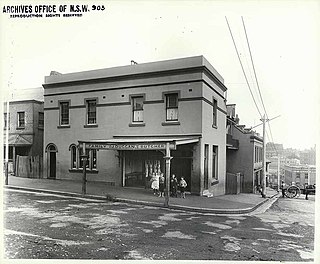
The Butchery Building is a heritage-listed restaurant and former terraced houses and butcher's shop located at 178-180 Cumberland Street, in the inner city Sydney suburb of The Rocks in the City of Sydney local government area of New South Wales, Australia. It was built from 1890 to 1899. It is also known as The Butchery Buildings. The property is owned by Property NSW, an agency of the Government of New South Wales. It was added to the New South Wales State Heritage Register on 10 May 2002.

The Cumberland Place and Steps are heritage-listed steps and a laneway located at Cumberland Place, in the inner city Sydney suburb of The Rocks in the City of Sydney local government area of New South Wales, Australia. It was built from 1807. It is also known as Suffolk Lane; Stubbs Lane; Gloucester Lane; and Cribb's Lane. The property is owned by Property NSW, an agency of the Government of New South Wales. It was added to the New South Wales State Heritage Register on 10 May 2002.

182 Cumberland Street, The Rocks is a heritage-listed retail building and residence located at 182 Cumberland Street, in the inner city Sydney suburb of The Rocks in the City of Sydney local government area of New South Wales, Australia. It was designed by Walter Liberty Vernon with the assistance of E. L. Drew and built from 1911 to 1912. The property is owned by Property NSW, an agency of the Government of New South Wales. It was added to the New South Wales State Heritage Register on 10 May 2002.
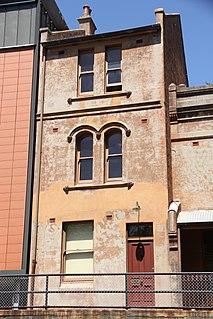
The Long's Lane Precinct, also Longs Lane Precinct, comprise a series of heritage-listed terrace houses located at 130 Cumberland Street, 132-134 Cumberland Street, 136-138 Cumberland Street, and 140-142 Cumberland Street, in the inner city Sydney suburb of The Rocks in the City of Sydney local government area of New South Wales, Australia. The terraces houses were built from 1888 to 1914. They are also known as 130 Cumberland Street; 132-134 Cumberland Street; 136-138 Cumberland Street; Watson's Butchery; and 140-142 Cumberland Street. The properties are owned by Property NSW, an agency of the Government of New South Wales. The precinct and the terrace houses were added to the New South Wales State Heritage Register on 10 May 2002.

117-117a Gloucester Street, The Rocks is a heritage-listed terrace houses located in the Long's Lane Precinct at 117-117a Gloucester Street, in the inner city Sydney suburb of The Rocks in the City of Sydney local government area of New South Wales, Australia. It was designed by W. Foggitt and built from 1912 to 1915. It is also known as Longs Lane Terraces/Precinct (Long's). The property is owned by Property NSW, an agency of the Government of New South Wales. It was added to the New South Wales State Heritage Register on 10 May 2002.

Baker's Terrace are heritage-listed commercial office buildings and former terrace houses located at 66-68 and 70-72 Gloucester Street, in the inner city Sydney suburb of The Rocks in the City of Sydney local government area of New South Wales, Australia. It was built during 1875 for William Andrews and Edward Baker. It is also known as Bakers Terrace. The property is owned by Property NSW, an agency of the Government of New South Wales. It was added to the New South Wales State Heritage Register on 10 May 2002.

71 Harrington Street, The Rocks are heritage-listed serviced apartments and former terrace houses and shops located at 71 Harrington Street, in the inner city Sydney suburb of The Rocks in the City of Sydney local government area of New South Wales, Australia. It was built from 1860. It is also known as Sailors Return Hotel; Stafford Apts. and 75 Harrington Street; Clocktower Development. The property is owned by Property NSW, an agency of the Government of New South Wales. It was added to the New South Wales State Heritage Register on 10 May 2002.

67 Harrington Street, The Rocks is a heritage-listed serviced apartments complex and former terrace house located at 67 Harrington Street, in the inner city Sydney suburb of The Rocks in the City of Sydney local government area of New South Wales, Australia. It was built from 1885. It is also known as Stafford Apartments and 75 Harrington Street; Clocktower Development. The property is owned by Property NSW, an agency of the Government of New South Wales. It was added to the New South Wales State Heritage Register on 10 May 2002.

61-65 Harrington Street, The Rocks is a heritage-listed serviced apartments and former terrace house located at 61-65 Harrington Street, in the inner city Sydney suburb of The Rocks in the City of Sydney local government area of New South Wales, Australia. It was built from 1870 to. It is also known as Stafford Apartments and 75 Harrington Street; Clocktower Development. The property is owned by Property NSW, an agency of the Government of New South Wales. It was added to the New South Wales State Heritage Register on 10 May 2002.

The View Terrace facades are heritage-listed offices and a former residence and terrace houses located at 26-30 Gloucester Street, in the inner city Sydney suburb of The Rocks in the City of Sydney local government area of New South Wales, Australia. It was built from 1893 to 1893. It is also known as Formerly 22-30 Gloucester Street and part of 40 Gloucester Street development. The property is owned by Property NSW, an agency of the Government of New South Wales. It was added to the New South Wales State Heritage Register on 10 May 2002.








